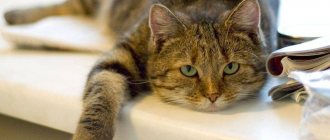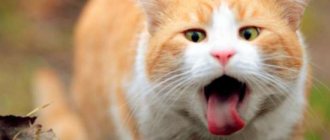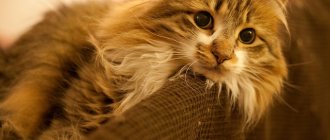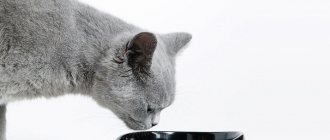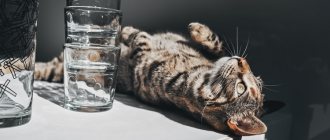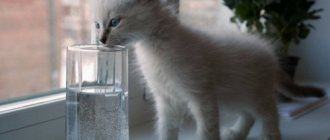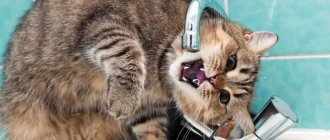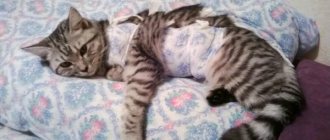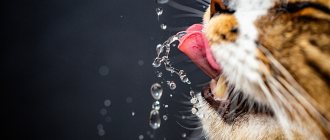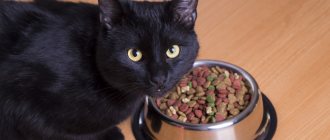Dystrophy literally translated from Greek means nutritional disorder. This term essentially means a pathological process during which cellular metabolism is disrupted, leading to changes in their structure. Due to the damage, both the structure and the intercellular space change, which together leads to dysfunction as a whole.
The basis of the pathology is a violation of tissue nutrition, which ensures the metabolism and integrity of cells and their structures.
The basis of the power mechanism:
- Transport of nutrients.
- Intercellular mesenchyme system.
- Nervous and hormonal regulation.
Any disruption of the links in the chain of the trophic system leads to one of the types of dystrophy.
Causes
Most often, cats suffer from nutritional dystrophy. This disease is not always associated with malnutrition, although it is at the origins of this type of pathology.
Factors that provoke dystrophy include:
- Depletion of reserves
, especially glycogen - the animal body is designed in such a way that it can withstand fairly long periods without food. This is due to problems in obtaining food. Therefore, a thrifty organism puts aside valuable reserves “for later.” With prolonged fasting or insufficient intake of certain substances, reserves are depleted, leading to disorders and dystrophy. - Excessive exploitation of the animal
- occurs as a result of excess loads, when nutrition cannot cover increased needs, in addition, the body works at the limit of its capabilities, taking all reserves and becoming sharply depleted. - Disorders of the gastrointestinal tract
- in particular, these include absorption pathologies. In this case, the cat simply cannot absorb the necessary nutrients in the required quantities. - Poor nutrition
– cats, like all animals and people, require a certain set of nutrients for the normal functioning of the body. With poor nutrition, nutrient deficiency occurs, which over time leads to the development of a systemic type of dystrophy.
Muscular dystrophy is a hereditary disease that is associated with the sex chromosome X. The trait is recessive, so only males can inherit this disease. Short-haired cats are considered to be the most susceptible to this mutation.
Natural food for an exhausted cat
It is impossible to give food from the common table to a weakened animal. It is undesirable to give dry food, since chewing and digesting it requires a lot of energy, which is in short supply in an exhausted cat. Also, dry food causes severe thirst, and a state of exhaustion may be accompanied by a refusal to drink. Give natural food or buy ready-made wet food.
A weakened animal needs high-calorie food. Weight should grow not through fat, but through muscle, so it is very important to consume a lot of protein. At least 50% of an emaciated cat’s diet comes from meat, but not pork! Fatty foods are prohibited, as the animal’s liver cannot cope with the load.
They are given raw and only fresh food is prepared.
What you are allowed to give:
- boiled meat - chicken breast, turkey, beef, lamb, rabbit;
- raw meat - beef without veins, turkey;
- offal - raw beef liver, boiled beef heart (scrolled through a meat grinder);
- cooked sea fish;
- raw eggs - chicken, quail;
- fermented milk products - low-fat kefir, cottage cheese, sour cream, yogurt without filler (in the absence of diarrhea);
- cereals – buckwheat, rice, oatmeal, bran;
- drink - rice water, low-fat chicken broth;
- baby meat food in jars.
Exhausted cats are given crushed food so as not to waste energy on chewing large pieces. To prevent your young pet from refusing food, grind it with a blender. If the cat is an adult, then finely chop the food. Stimulate a weak appetite with something attractively smelling or crunchy, but give it a very small piece.
The food should not be hot; warm it to room temperature. If your cat doesn't eat the food right away, put it in the refrigerator to offer later.
Development of dystrophy
Nutritional dystrophy begins with a deficiency of carbohydrates, which occurs during prolonged fasting. Glycogen stores are depleted. The main reservoir of carbohydrates is the liver; due to its depletion, a signal is sent to the receptors. Subsequently, it enters the nervous system and travels through afferent pathways to adipose tissue.
At this stage, hormones are activated, which signal the breakdown of fats and the release of fatty acids into the blood. Fat becomes the main source of energy.
This replenishment of organs leads to increased formation of breakdown products - ketone bodies, which are toxins for the body. Poisoning inhibits basic processes and reduces the functioning of vital systems - the liver, digestion, endocrine function and reproductive system.
Muscular dystrophy
In the muscular variant, the main culprit is a defective gene on the X chromosome. It is responsible for the production of the protein dystrophin, the function of which is the stability of the muscle cell membrane. Because of this, the structure of the cell membrane and its functioning are disrupted.
Why is the cat skinny?
A cat may look thin for completely natural reasons. In most cases, with a good appetite, the animal soon begins to recover and returns to normal. Natural (physiological) reasons include :
- Feeding offspring - the thinness of a cat during the period of feeding kittens should not be a cause for concern. The female will recover after the cubs switch to regular cat food.
- Mating period - during the mating season, cats tend to lack appetite due to hormonal stress. This is especially true for animals accustomed to walking on their own.
- Stress – Cats can become stressed in certain situations. At the same time, the animal loses weight because it eats little or refuses food. The reason may be a move, a change of owner, or the arrival of a child, another cat or dog in the house.
- Changing food - if a cat is offered a new food, he may eat it less or refuse the treat altogether. If over time the animal does not adapt, it is necessary to return to its usual diet.
- Age – If the pet is young, overly active, often plays and moves a lot, weight loss is considered a natural consequence. Older cats also tend to become thinner as the body stops storing fat. In this case, it is necessary to visit a veterinarian to rule out diseases.
Physiological reasons do not cause concern, but you can pay attention to the animal’s diet - whether it is healthy and nutritious enough.
© shutterstock
It’s bad if the cat shows signs of exhaustion, this indicates the presence of diseases. If the cat has lost a lot of weight, most likely the reason lies in one of the pathologies :
- Parasites – helminths – are a very common cause of pet thinness. Helminthic infestation disrupts the animal's digestive processes. And the waste products of parasites lead to intoxication of the body. Therefore, it is important to give your cat anthelmintic drugs on time.
- Infectious diseases - diseases such as calcevirosis, panleukopenia, viral peritonitis and rhinotracheitis are accompanied by dehydration and lack of appetite. Symptoms: discharge from the nose and eyes, diarrhea, high fever. If these signs appear, you should immediately contact a veterinarian. Lack of timely treatment can lead to death.
- Oncology – the presence of malignant tumors can also cause exhaustion. If a tumor is suspected, the veterinarian will prescribe an ultrasound.
- Teeth and gums – it happens that a cat cannot eat for dental reasons. If an animal is interested in food, but cannot eat, it is necessary to show it to a specialist.
- Other diseases – almost any disease can lead to weight loss. A cat loses weight if it has problems with the kidneys, liver, heart, thyroid gland, metabolic disorders, or viral diseases. An accurate diagnosis can only be made by a qualified specialist.
Any of the pathologies requires immediate veterinary intervention. Only a veterinarian can determine why a cat is thin and prescribe the necessary treatment. A preventive visit to the clinic once a year is also recommended to check the general health of the animal.
Symptoms
The leading clinical sign of nutritional malnutrition is loss of body weight. Depending on the percentage of underweight, three stages are distinguished:
- First degree – loss is up to 20 percent.
- The second degree is depletion of 30 percent of body weight.
- Third degree – above 30 percent.
Critical wasting is a loss of 40 percent of total body weight. Such a deficiency leads to the death of the pet.
At the first stage
– the cat noticeably loses weight, the pelvic bones, ribs and spine become visible. The animal becomes less active and lethargic. This stage is fully compensated for by establishing nutrition, leaving no negative consequences for the body.
At the second
and third stages,
dryness and pallor of the mucous membranes and skin occur, the coat is dry and dull, and the cat has a characteristic disheveled appearance. Problems with stool begin due to a decrease in the productive functioning of the gastrointestinal tract and inhibition of absorption. The work of the heart is disrupted - the sounds are dull and weak.
The appearance of shortness of breath and slow breathing is also characteristic, and body temperature decreases.
If the loss of more than 30 percent of the cat no longer gets up due to exhaustion, anorexia begins (refusal of food), dry feces, and frequent constipation.
The second and third forms of dystrophy lead to changes in internal organs:
- Atrophic changes in organs and muscles.
- Accumulation of exudate in the pleural cavity, as well as in the subcutaneous tissue, omentum and kidney capsules.
- Fatty involution of the liver; with a long course of dystrophy, the development of cirrhosis is possible.
- Protein deposition in the kidneys with the development of glomerulonephritis.
- Disruption of the endocrine system, which leads to pathology of the reproductive system - involution of the uterus, ovarian atrophy, disruption of the reproductive cycle and follicle maturation. In cats, sperm production is suppressed.
At the third stage, changes in organs are irreversible and complete recovery is no longer possible.
Symptoms of muscular dystrophy
The cat has weakness in the muscles, which can be detected in the peculiarities of its gait - it becomes jumping, reminiscent of walking on stilts. The animal quickly gets tired, stiffness of movements is observed, and there may be disturbances in swallowing due to weakness of the muscles of the esophagus and an enlarged tongue. Possible respiratory failure and kidney failure.
Signs of exhaustion
Wasting is defined as weight loss of more than 10% of total body weight. This phenomenon causes energy imbalance. Exhaustion can occur in sick and older cats; it appears during estrus, after giving birth and feeding kittens, and becomes a consequence of stress.
The owners do not always turn to the veterinarian, since the ward may have an appetite and be active. However, significant weight loss can be caused by a serious illness. If you notice warning signs, you should consult a specialist.
What indicates exhaustion:
- the animal is lethargic and apathetic;
- the figure resembles an hourglass;
- the stomach is sunken;
- there is no fat layer on the ribs.
Before you start feeding an emaciated cat, cure the disease or relieve the acute condition. Even the highest quality food over the clock will not give results, but will only cause gastrointestinal upset.
Diagnostics
Since dystrophy is a systemic process, it is mandatory to conduct a general examination of the body - a general blood and urine test to establish the level of hemoglobin (if depleted, it will always be very low, and the formed elements of the blood - leukocytes and erythrocytes - also decrease) and an assessment of kidney function (usually there is a decrease in sugar and protein, as well as urine density).
A biochemical blood test reveals ketone bodies, and it is also possible to increase the level of liver enzymes with liver damage.
Be sure to examine the stool, it helps to assess the functioning of the intestines.
X-ray and ultrasound of internal organs will help determine the presence of fluid and changes in internal organs.
To diagnose muscular dystrophy, histological examination of muscle tissue is used. Dystrophin deficiency is confirmed using immunocytological analysis.
Ready-made feed
Some cat food manufacturers offer special options for weight gain and malnutrition. This food is characterized by a high content of fats and proteins, useful substances that will help the animal recover faster. The paste-like consistency makes it easier for your cat to eat its food. A lot of energy will not be spent on digesting special medicinal food.
High-protein foods are another option for quickly gaining weight for an overly thin cat. To get the maximum effect from such food, make sure that the protein source is listed first in the composition - rabbit, chicken, beef, etc. It’s good if the composition contains a source of taurine.
Along with ready-made food, a weakened cat can be supported with biologically active and vitamin supplements, but only after consultation with a veterinarian.
Treatment
The basis of therapy for nutritional dystrophy is the gradual regulation of metabolic processes and restoration of organ functioning.
A diet is required. The calorie content of the diet should be increased slowly, with a parallel restoration of the gastrointestinal tract. Portions should be small, and the number of feedings should be increased to 5-7 times a day.
The diet includes liver, meat, fish, dairy products, cereals and soups with meat broth. They also give additional fish oil.
To restore microflora and improve digestion, acidophilic broth cultures are used. They help prevent the development of bacterial complications in the intestines and improve the digestion of carbohydrates.
Magnesium sulfate is used to restore appetite.
In case of severe exhaustion, infusion therapy using a solution of 5% glucose and protein preparations (for example, hydrolysine) is additionally required.
Intramuscular administration of vitamins and immunostimulating drugs (Glycopin, Gamavit) is mandatory.
Muscular dystrophy
It is impossible to cure this disease. You can only symptomatically alleviate the animal’s condition and correct breathing problems and weakness.
Steroid drugs - used to restore muscles and combat weakness. They also help slow the progression of the disease. They are prescribed for life, but they only relieve symptoms.
Loss of appetite in a cat
The goal of treatment is to find the underlying cause, provide treatment, and provide support.
A set of measures aimed at solving:
- Encourage your cat to eat because nutrients are very important for her recovery. Offer very tasty foods such as tuna, shrimp, shredded chicken or a very tasty paste such as Nutrigel.
- Use appetite stimulants.
Mirtazapine is an antidepressant that can also stimulate appetite. Maropitant citrate is an antiemetic (vomiting agent) that can also relieve nausea, which is a common reason why cats lose their appetite.
In some cases, mirtazapine and maropitant may be used together.
Other appetite stimulants include cyproheptadine (Periactin), an antihistamine, and corticosteroids such as prednisone.
- Use a feeding tube.
If the above methods do not work and your cat is still not eating, you may need to tube feed your cat until her appetite returns. The feeding tube is a plastic tube that is placed either through the nose (naso-esophageal feeding tube), through the skin of the neck and into the esophagus (esophagostomy feeding tube), or through the abdominal wall and into the stomach (gastrostomy feeding tube). Soft and watery food is placed in the feeding tube to ensure your cat has enough nutrition until her appetite returns. Once the tube is inserted, the cat can be treated on its own at home.
- Antibiotics to treat bacterial infections.
Supportive care – such as fluid therapy to treat dehydration and anticancer drugs.
Non-medical causes of anorexia:
- Dirty food bowls and trays pose a natural risk because old (stale) food has an unpleasant odor. It is necessary to regularly wash your cat's dishes in hot soapy water once a day.
- Sharing a food bowl. Cats are not social eaters, they prefer to eat on their own, so if you have several cats in the house, stick to the rule that each cat should have its own food bowl.
- Eating space is very important. Food and water cups should not be placed in close proximity to trash cans. Bowls should be located in an area that is easy to access but subject to high traffic.
- Sudden changes in diet. Cats that have been fed one type of food are very sensitive to changes in diet. If you want (or need) to change your cat's diet, do it over the course of a few days. Start by adding a small amount of the new food to his regular food and slowly increase the amount of new food. Loss of appetite is often one of the first signs that your cat is not feeling well. Always be vigilant and aware of how much your cat is eating and whether a loss of appetite needs to be consulted by a veterinarian.
- Having several animals in the house. Providing each member with their own place to eat will allow them to feel calm while eating.
Chronic kidney disease
Chronic kidney disease is one of the most common diseases in older cats.
The kidneys produce important hormones, filter waste from the blood, help regulate blood pressure, and promote the production of new red blood cells. When a cat's kidneys stop functioning properly, it leads to a variety of other problems.
Increased thirst and urination are among the first signs of kidney disease in a cat, followed by loss of appetite, weight loss and lethargy.
Chronic kidney disease cannot be completely cured, but it can often be treated with medications, diet changes, and fluid intake.
Stress
Cats can be very sensitive to changes in the home. Because they are often good at hiding outward signs of stress, they may develop more severe symptoms later.
Any environmental factors can cause anxiety and stress in a cat. Decreased appetite is a common sign of stress, which ultimately leads to weight loss.
There are a number of other health problems that can lead to weight loss. If your cat has a health problem, you may or may not notice other signs of illness.
In addition, many diseases have similar symptoms, so a veterinarian is needed for diagnosis.
Dental problems
Oral and dental problems can cause severe pain, reduce appetite and lead to weight loss. Common dental problems in cats include periodontal disease, resorptive lesions, and dental fractures.
Some cats develop stomatitis, a painful inflammation of the cat's mouth and gums that may be immune-mediated.
Signs of dental problems include bad breath, drooling, paws in the mouth, or even bleeding from the mouth.
The first step to treatment is for your veterinarian to give your cat anesthesia and, if necessary, professional dental cleaning, examination, and treatment. Some cats will require oral surgery and/or tooth extraction.
